**Chemical and Biological Properties of Trehalose**:
– Trehalose is a disaccharide with a stable nonreducing sugar structure.
– It forms rhomboid crystals as a dihydrate and self-associates in water.
– Found in various organisms like bacteria, yeast, fungi, insects, and plants.
– Acts as a major carbohydrate energy storage molecule in insects.
– Functions in cryptobiosis through vitrification or water displacement theories.
**Synthesis and Metabolism of Trehalose**:
– Trehalose can be synthesized through three biological pathways or derived from corn starch industrially.
– Five biosynthesis pathways have been reported for trehalose.
– The most common biosynthesis pathway involves trehalose-6-phosphate synthase.
– Vertebrates lack the ability to synthesize or store trehalose.
– Trehalase in humans is found in specific locations like the intestinal mucosa and liver.
**Nutritional and Dietary Properties of Trehalose**:
– Rapidly broken down into glucose by the enzyme trehalase.
– Causes a lower spike in blood sugar compared to glucose.
– About 45% as sweet as sucrose at concentrations above 22%.
– Commonly used in frozen foods to lower the freezing point.
– Deficiency in trehalase enzyme is rare in humans but more common in specific populations like the Greenlandic Inuit.
**Research Insights and Related Concepts**:
– Trehalose has been studied for its self-association in binary aqueous solutions and its role in DNA melting.
– Related concepts include biostasis, cryoprotectant, cryptobiosis, and freeze-drying.
– Research has explored trehalose’s bioactivities, enzymatic synthesis, and its potential in treating conditions like Spinocerebellar Ataxia.
– Studies have investigated trehalose’s impact on pathogens and its relationship with Clostridium difficile infections.
**Discovery and Enzymatic Synthesis of Trehalose**:
– Trehalose was discovered in 1832 and isolated from Trehala manna in 1859.
– It has been identified as an autophagy inducer independent of mTOR.
– Enzymatic synthesis of trehalose esters and their stabilization properties have been studied.
– Trehalose has shown potential in various applications, including as artificial tear drops for dry eye syndrome.
– Trehalose has been researched in neuroscience, with studies focusing on autophagy, lysosomes, and brain health.
Trehalose (from Turkish tıgala – a sugar derived from insect cocoons + -ose) is a sugar consisting of two molecules of glucose. It is also known as mycose or tremalose. Some bacteria, fungi, plants and invertebrate animals synthesize it as a source of energy, and to survive freezing and lack of water.

| |

| |

| |
| Names | |
|---|---|
| IUPAC name
α-D-glucopyranosyl-(1→1)-α-D-glucopyranoside
| |
| Systematic IUPAC name
(2R,3S,4S,5R,6R)-2-(Hydroxymethyl)-6-[(2R,3R,4S,5S,6R)-3,4,
5-trihydroxy-6-(hydroxymethyl)oxan-2-yl]oxyoxane-3,4,5-triol | |
| Other names
α,α‐Trehalose
| |
| Identifiers | |
3D model (JSmol)
|
|
| ChEBI | |
| ChEMBL | |
| ChemSpider | |
| ECHA InfoCard | 100.002.490 |
PubChem CID
|
|
| UNII | |
CompTox Dashboard (EPA)
|
|
| |
| |
| Properties | |
| C12H22O11 (anhydride) | |
| Molar mass | 342.296 g/mol (anhydrous) 378.33 g/mol (dihydrate) |
| Appearance | White orthorhombic crystals |
| Density | 1.58 g/cm3 at 24 °C |
| Melting point | 203 °C (397 °F; 476 K) (anhydrous) 97 °C (dihydrate) |
| 68.9 g per 100 g at 20 °C | |
| Solubility | Slightly soluble in ethanol, insoluble in diethyl ether and benzene |
Except where otherwise noted, data are given for materials in their standard state (at 25 °C [77 °F], 100 kPa).
| |
Extracting trehalose was once a difficult and costly process, but around 2000, the Hayashibara company (Okayama, Japan) discovered an inexpensive extraction technology from starch. Trehalose has high water retention capabilities, and is used in food, cosmetics and as a drug. A procedure developed in 2017 using trehalose allows sperm storage at room temperatures.
